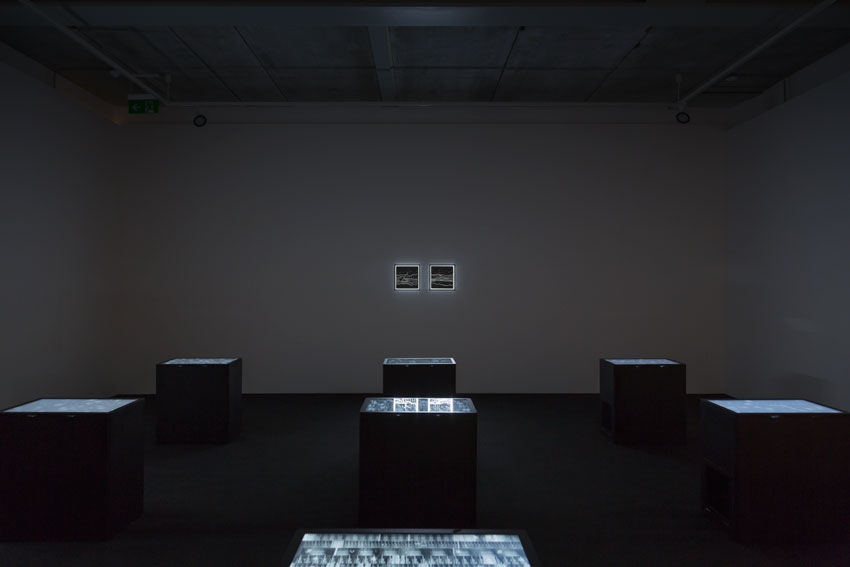Almine Rech Gallery, London, 6 April – 20 May 2017
Comparing his 4’33” (1952) to Nam June Paik’s Zen for Film (1965), John Cage wrote in 1968, ‘in the music [of 4’33”], the sounds of the environment remain, so to speak, where they are… In the case of the Nam June Paik film, which has no images… [t]he nature of the environment is more on the film.’ Consisting simply of 6,552 frames of blank 16mm film with sound stripe, hung on a wall in 55 rows in an almost square frame, Ryoji Ikeda’s own 4’33” [gray] (2014) makes clear reference both to Cage’s ‘silent’ composition and Paik’s unexposed film, but its means and effect are entirely different. The ‘environment’ is irrelevant to Ikeda’s own silent composition. What we focus on instead is the nature of the medium itself, its physical properties as an immediately graspable image of time transformed into space (88 x 92 cm of space, to be exact). 4’33” [gray] is one of a series of works on this theme occupying the middle room of a show that is otherwise less concerned with silence than with the indistinguishability of signal and noise.
Walking through Ikeda’s generous three-room exhibition, it is tempting to accuse the electronic-musician-turned-artist of a kind of fetishism. What works on paper like the irrational (ø) [n°1-2b] (2017), a seemingly random grey scree (reminiscent of the ‘snow’ of TV static), share with the more sculpturally presented data. scan [n°2] (2011) – one of nine LED screens laid flat and raised to thigh-height on a wooden box flickering with the rapid scroll of figures representing, in this case, the DNA sequencing of chromosome 11 (with others encoding the structure of the universe, of protein, or of a four-dimensional hypercube) – is an impression of information as something dizzying and unfathomable in the face of which we can only gaze admiringly. The works come off like a geek’s dream of the nineteenth-century sublime, with mountains of data replacing the rocky peaks once gazed upon by Friedrich’s famous Wanderer.
But there is something more at stake here. Ikeda’s fascination is with the medium, not the message; his peers in this case are not so much Baudelaire as Marshall McLuhan, Jussi Parikka and Bruce Sterling. On the walls surrounding the nine screens of the data.scan series hangs a kind of archaeology of dead media, recalling Sterling’s Dead Media Project, begun in 1995. Across the six backlit panels of the systematics series (2011–12), we see piano rolls, the punched tape of midcentury IBM computers, the aperture cards once used by the US Department of Defense. Together they present a history of increasing levels of abstraction, a progressive shift from the human-readable to the inscrutable high-speed streams of numbers on the screens in the middle of the room.
Let’s return, then, to the six recent works that open this show – in particular, the more-or- less plain white the irrational (ø) [n°1-c] (2017). This work, expressing – so the exhibition text explains – the first 1,452,384 decimal digits of the irrational number ø (the so-called ‘golden ratio’), is most productively interpreted neither in terms of ‘airports for particles of dust and shadows’ (as Cage, in the same 1968 essay, said of Robert Rauschenberg’s 1951 White Painting triptych); nor as some sort of lame statement about the unique and ineffable beauty of mathematics (after all, there is nothing unique about a white piece of paper). Better to see here a statement about how humans have increasingly created systems of representation that make the parameters of their own world oblique and incomprehensible to anything but machine intelligence. Whether that should be regarded as cause for lament or celebration probably depends on whether you, dear reader, are a human or a machine.
From the Summer 2017 issue of ArtReview.
